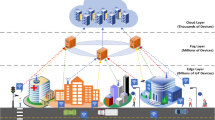Abstract
Cloud service providers emphasize the concept of virtual machines, wherein resources and services are accessed over a distributed network system. The loss of user privacy is indeed contempt in concern to any individual or organization, particularly concerning the Healthcare infrastructure. This research paper introduces a Euclidean L3P-based Multi-Objective Successive Approximation (EMSA) algorithm, an efficient measure of privacy in the Healthcare Cloud. The role-based encryption keys are the critical foundation for the storage of sensitive data in cloud environments is presented here. The proposed EMSA algorithm is the hybridization of the existing Euclidean L3P Distance algorithm, Multi-objective Optimization algorithm, and Successive Approximation Iterative Proximate algorithm. In addition, the performance of the proposed EMSA compared with Bat, PUBAT, TPNGS, WOA, and CIC-WOA algorithms based on performance metrics, such as fitness, privacy, and utility. The simulation shows that, comparison to the existing state-of-the-art algorithms, the proposed EMSA model achieves higher privacy values of 0.34, 0.42, 0.42, 0.35, and 0.30.

Source: Proposed architecture by author






Similar content being viewed by others
Code availability
Not Applicable.
References
Agarkhed, J., Deshpande, A., & Saraf, A. (2020). Data De-duplication Scheme for File Checksum in Cloud. Social Networking and Computational Intelligence (pp. 105–117). Singapore: Springer.
Do, K., Tran, T. and Venkatesh, S., (2016) Multilevel anomaly detection for mixed data. arXiv preprint
Do, K., Tran, T., & Venkatesh, S. (2018). Energy-based anomaly detection for mixed data. Knowledge and Information Systems, 57(2), 413–435.
Fang, C., Guo, Y., Wang, N., & Ju, A. (2020). Highly efficient federated learning with strong privacy preservation in cloud computing. Computers & Security, 96, 101889.
Gomathi, N., & Karlekar, N. P. (2019). Ontology and Hybrid Optimization Based SVNN for Privacy Preserved Medical Data Classification in Cloud. International Journal on Artificial Intelligence Tools, 28(03), 1950009.
Guerrero, C., Lera, I., & Juiz, C. (2018). Genetic algorithm for multi-objective optimization of container allocation in cloud architecture. Journal of Grid Computing, 16(1), 113–135.
Han, S., Lin, J., Zhao, S., Xu, G., Ren, S., He, D., et al. (2020). Location Privacy-Preserving Distance Computation for Spatial Crowdsourcing. IEEE Internet of Things Journal, 7(8), 7550–7575.
Kaaniche, N., & Laurent, M. (2017). Data security and privacy preservation in cloud storage environments based on cryptographic mechanisms. Computer Communications, 111, 120–141.
Karlekar, N. P., & Gomathi, N. (2017). Kronecker product and bat algorithm-based coefficient generation for privacy protection on cloud. International Journal of Modeling, Simulation, and Scientific Computing, 8(03), 1750021.
Kundalwal, M. K., Chatterjee, K., & Singh, A. (2019). An improved privacy preservation technique in health-cloud. ICT Express, 5(3), 167–172.
Li, C. T., Shih, D. H., & Wang, C. C. (2018). Cloud-assisted mutual authentication and privacy preservation protocol for telecare medical information systems. Computer methods and programs in biomedicine, 157, 191–203.
Li, K., & Wang, J. (2017). Multi-objective optimization for cloud task scheduling based on the ANP model. Chinese Journal of Electronics, 26(5), 889–898.
Midya, S., Roy, A., Majumder, K., & Phadikar, S. (2018). Multi-objective optimization technique for resource allocation and task scheduling in vehicular cloud architecture: A hybrid adaptive nature inspired approach. Journal of Network and Computer Applications, 103, 58–84.
Revathi, S. T., Ramaraj, N., & Chithra, S. (2019). Brain storm-based Whale Optimization Algorithm for privacy-protected data publishing in cloud computing. Cluster Computing, 22(2), 3521–3530.
Shivanna, K., Deva, S. P., & Santoshkumar, M. (2017). Privacy preservation in cloud computing with double encryption method. Computer Communication Networking and Internet Security (pp. 125–133). Singapore: Springer.
Subramaniyam, A., Mahapatra, R. P., & Singh, P. (2019). Taylor and Gradient Descent-Based Actor Critic Neural Network for the Classification of Privacy Preserved Medical Data. Big data, 7(3), 176–191.
Wang, X., Bai, L., Yang, Q., Wang, L., & Jiang, F. (2019). A dual privacy-preservation scheme for cloud-based eHealth systems. Journal of Information Security and Applications, 47, 132–138.
Xiao, Z., Liu, G., He, D., Guo, Y., & Du, J. (2020). Concurrent request multiplexing for cloud composite service reservation. IEEE Transactions on Services Computing. https://doi.org/10.1109/TSC.2020.2967379.
Zhang, G., Liu, X., & Yang, Y. (2014). Time-series pattern based effective noise generation for privacy protection on cloud. IEEE Transactions on Computers, 64(5), 1456–1469.
Zhang, G., Yang, Y. and Chen, J., 2013, July. A privacy-leakage-tolerance based noise enhancing strategy for privacy protection in cloud computing. In 2013 12th IEEE International Conference on Trust, Security and Privacy in Computing and Communications (pp. 1–8). IEEE.
Funding
All sources of funding for the research work and their role in the design of the study and collection, analysis, interpretation of data, and in writing the manuscript should be declared.
Author information
Authors and Affiliations
Corresponding author
Ethics declarations
Conflict of interest
The authors declare that they have no conflict of interest. The manuscript was written through contributions of all authors. All authors have given approval to the final version of the manuscript.
Availability of data and material
Not Applicable.
Additional information
Publisher's Note
Springer Nature remains neutral with regard to jurisdictional claims in published maps and institutional affiliations.
Rights and permissions
About this article
Cite this article
Sathya, A., Raja, S.K.S. Privacy Preservation-Based Access Control Intelligence for Cloud Data Storage in Smart Healthcare Infrastructure. Wireless Pers Commun 118, 3595–3614 (2021). https://doi.org/10.1007/s11277-021-08278-6
Accepted:
Published:
Issue Date:
DOI: https://doi.org/10.1007/s11277-021-08278-6




